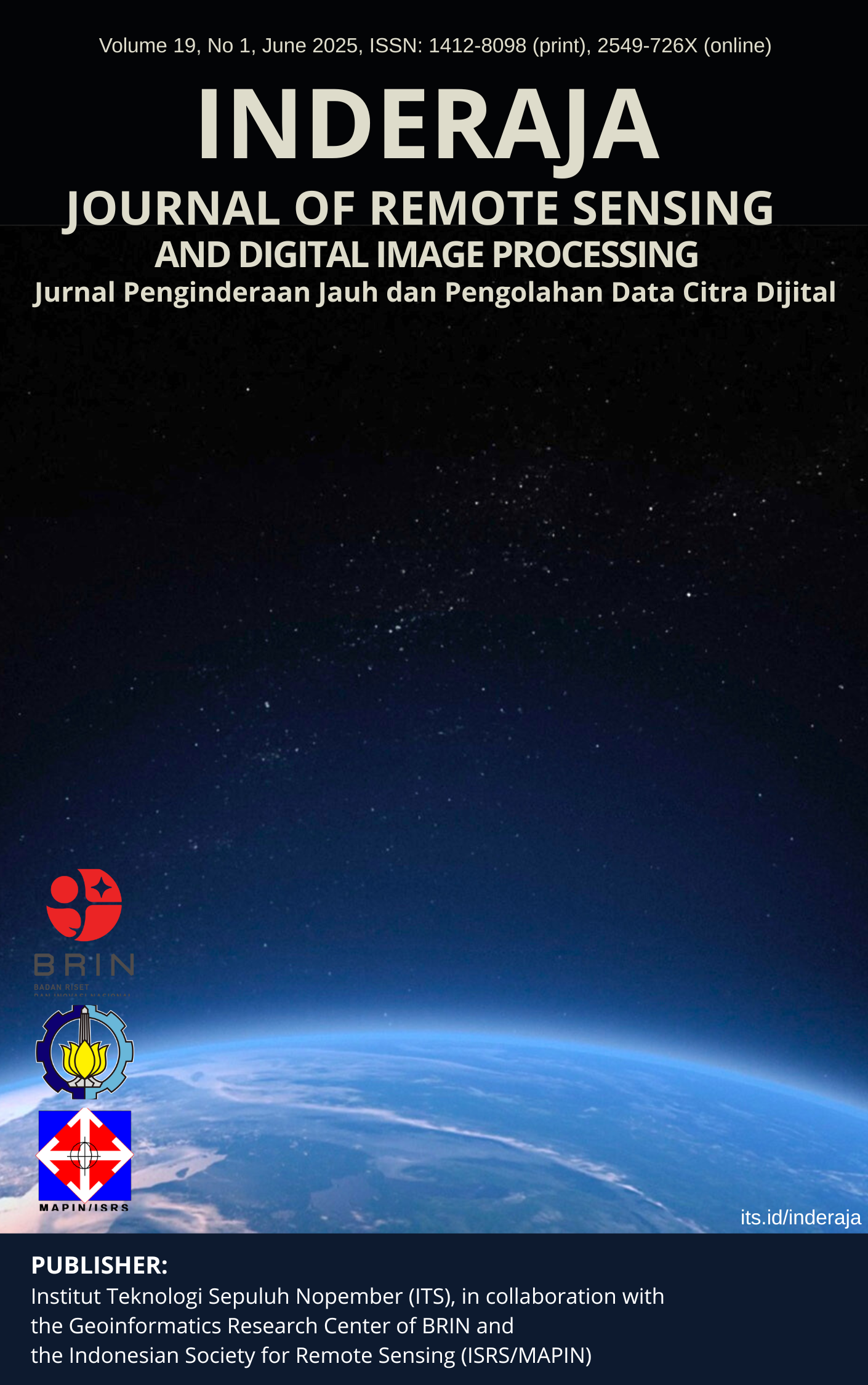Comparative Analysis of SAVI and NDVI Correlations with Land Surface Temperature in Mandalika Special Economic Zone Using Landsat 8 Imagery
Main Article Content
Abstract
The rapid infrastructure development within the Mandalika Special Economic Zone (SEZ) has significantly altered land cover and potentially influenced land surface temperature (LST). This study aims to compare the correlation strength of two remote sensing-based vegetation indices, Normalized Difference Vegetation Index (NDVI) and Soil Adjusted Vegetation Index (SAVI) with LST to determine which index better represents surface temperature variability in areas undergoing rapid development. Landsat 8 imagery from 2014 to 2023 was used to derive NDVI, SAVI, and LST values. Spearman’s Rho correlation and simple linear regression were employed to evaluate the strength and consistency of the relationships between vegetation indices and LST. The Shapiro – Wilk test confirmed that all variables were not normally distributed, leading to the use of Spearman's rho correlation. Both indices showed significant negative correlations with LST, with NDVI slightly stronger (r = -0.555) than SAVI (r = -0.536). Simple linear regression revealed NDVI had a higher R² (0.392) and lower residual error than SAVI, indicating a more robust model fit. Although SAVI is more suitable in mixed land cover conditions due to its soil background correction, NDVI provides stronger statistical performance in modeling LST in Mandalika SEZ. These findings support the strategic use of NDVI as a primary indicator in environmental planning and sustainable development monitoring or for Urban Heat Island mitigation policy in developing regions.
Downloads
Article Details

This work is licensed under a Creative Commons Attribution-NonCommercial-ShareAlike 4.0 International License.
References
P. C. Guillevic et al., “Validation of Land Surface Temperature products derived from the Visible Infrared Imaging Radiometer Suite (VIIRS) using ground-based and heritage satellite measurements,” Remote Sens Environ, vol. 154, pp. 19–37, Nov. 2014, doi: 10.1016/j.rse.2014.08.013.
E. Debie, M. Anteneh, and T. Asmare, “Land Use/Cover Changes and Surface Temperature Dynamics Over Abaminus Watershed, Northwest Ethiopia,” Air, Soil and Water Research, vol. 15, Jan. 2022, doi: 10.1177/11786221221097917.
C. R. de Almeida, A. C. Teodoro, and A. Gonçalves, “Study of the Urban Heat Island (UHI) Using Remote Sensing Data/Techniques: A Systematic Review,” Environments, vol. 8, no. 10, p. 105, Oct. 2021, doi: 10.3390/environments8100105.
S. Huang, L. Tang, J. P. Hupy, Y. Wang, and G. Shao, “A commentary review on the use of normalized difference vegetation index (NDVI) in the era of popular remote sensing,” Feb. 01, 2021, Northeast Forestry University. doi: 10.1007/s11676-020-01155-1.
J. Xue and B. Su, “Significant Remote Sensing Vegetation Indices: A Review of Developments and Applications,” J Sens, vol. 2017, pp. 1–17, 2017, doi: 10.1155/2017/1353691.
A. E. Alfian, S. Hadi, and Ismail, “Mandalika Special Economic Zone and the Potential for Regional Economic Development of Central Lombok Regency through Investment,” Jurnal Economic Resource, vol. 5, no. 2, pp. 321–333, Sep. 2022, doi: 10.57178/jer.v5i2.371.
E. S. Rustidja, A. Purnamawati, and R. Setiawati, “European Journal of Economics and Business Studies Investment Promotion for Community Economic Development of Special Economic Zone: Study of Sez Mandalika and Bitung in Indonesia”.
T. R. Loveland and J. R. Irons, “Landsat 8: The plans, the reality, and the legacy,” Remote Sens Environ, vol. 185, pp. 1–6, Nov. 2016, doi: 10.1016/j.rse.2016.07.033.
T. Dev Acharya, I. Yang, and G. Student, “Exploring Landsat 8,” 2015. [Online]. Available: http://earthobservatory.nasa.gov/IOTD/
Z. Matienatul Iemaaniah, N. Asri Shakila, and A. Majid Azzuandi, “Identifikasi Penggunaan Lahan Menggunakan Citra Resolusi Tinggi di Titik Nol Kawasan Ekonomi Khusus Mandalika.” [Online]. Available: http://ejournal.unikama.ac.id/index.php/JPIG/
“USGS Landsat 8 Level 2, Collection 2, Tier 1 | Earth Engine Data Catalog | Google for Developers.” Accessed: May 17, 2025. [Online]. Available: https://developers.google.com/earth-engine/datasets/catalog/LANDSAT_LC08_C02_T1_L2
A. A. E. Ayek, “Comment on Yu et al. Land Surface Temperature Retrieval from Landsat 8 TIRS—Comparison between Radiative Transfer Equation-Based Method, Split Window Algorithm and Single Channel Method. Remote Sens. 2014, 6, 9829–9852,” Remote Sens (Basel), vol. 16, no. 14, 2024, doi: 10.3390/rs16142514.
J. M. Galve, “Assessment of Land Surface Temperature Estimates from Landsat 8-TIRS in A High-Contrast Semiarid Agroecosystem. Algorithms Intercomparison,” Remote Sens (Basel), vol. 14, no. 8, 2022, doi: 10.3390/rs14081843.
A. R. Huete, “A soil-adjusted vegetation index (SAVI),” Remote Sens Environ, vol. 25, no. 3, pp. 295–309, Aug. 1988, doi: 10.1016/0034-4257(88)90106-X.
A. R. Huete, “A soil-adjusted vegetation index (SAVI),” Remote Sens Environ, vol. 25, no. 3, pp. 295–309, Aug. 1988, doi: 10.1016/0034-4257(88)90106-X.
E. Szmidt and J. Kacprzyk, “The Spearman rank correlation coefficient between intuitionistic fuzzy sets,” in 2010 5th IEEE International Conference Intelligent Systems, 2010, pp. 276–280. doi: 10.1109/IS.2010.5548399.
P. Sedgwick, “Spearman’s rank correlation coefficient,” BMJ, p. g7327, Nov. 2014, doi: 10.1136/bmj.g7327.
C. Croux and C. Dehon, “Influence functions of the Spearman and Kendall correlation measures,” Stat Methods Appt, vol. 19, no. 4, pp. 497–515, Nov. 2010, doi: 10.1007/s10260-010-0142-z.
D. C. . Montgomery, E. A. . Peck, and G. Geoffrey. Vining, “Introduction to linear regression analysis,” p. 673, 2021, Accessed: May 27, 2025. [Online]. Available: https://books.google.com/books/about/Introduction_to_Linear_Regression_Analys.html?id=tCIgEAAAQBAJ
D. Sampelan, A. Baihaqi, and L. M. Jaelani, “Analyzing the Impact of Mandalika Special Economic Zone (SEZ) Development on Land Surface Temperature (LST) Using Landsat 8 Satellite Imagery,” in 2024 IEEE Asia-Pacific Conference on Geoscience, Electronics and Remote Sensing Technology (AGERS), IEEE, Dec. 2024, pp. 16–23. doi: 10.1109/AGERS65212.2024.10932919.

